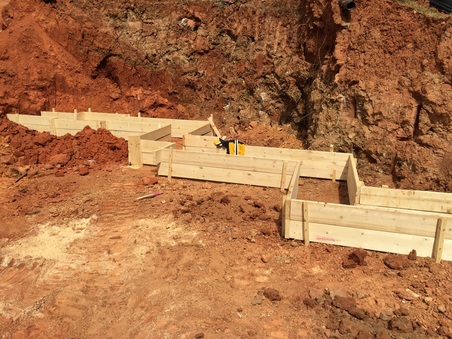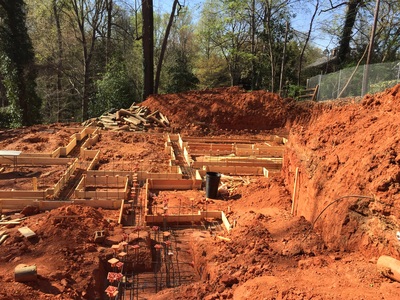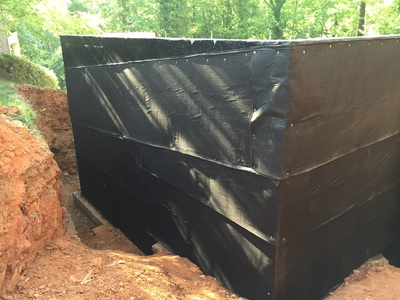|
Hello everyone, this is our third post in our custom home building blog for the custom home that we are building in town. We have had a good bit of progress so let’s get started. At the end of our last blog post we had just completed the pile driving process. Once that phase of construction was completed we marked the building location with our footing contractor in order to verify where the house footings were to be dug and poured. The picture below shows the blue paint indicating where the footings are to go. After the footings have been laid out the footing contractor then starts the process of building the forms that will hold the concrete in place when it is being poured. The picture below show some examples of this formwork. Because we had to use piles on this project the footing formwork is slightly different than normal. The picture below shows the footing excavated, formed and the pile sticking up through the bottom of the footing excavation. This is a very important detail when piles are being used. The pile is transferring the structural load of the house so it needs to be incorporated within the footing correctly. Placement of the steel rebar is the next step in the footing process. The two pictures below show the placement of the horizontal rebar and of the vertical rebar. The vertical rebar will be used once the footings have been poured and the forms for the poured concrete walls are put in place. When working on a house that has such a large footprint combined with a site that has very little access as well as some very steep topography we use a concrete pump to place the concrete for the footings. Below you will see a picture of the pump in action. Once the footings have been poured the forms for the poured walls are brought to the job and unloaded with a crane with the forms staged in baskets. Below you will see a picture of the footings poured and a picture of the forms being staged around the job. The wall forms are then erected around the perimeter of the job and the remaining horizontal and vertical rebar are installed that are to be imbedded in the concrete walls. Below you will see pictures of the forms in place as well as a picture looking through the forms showing the rebar. Once all of the wall forms and rebar are in place we then bring pack the same pump that was used for the footings. This pump will fill the forms with concrete. Below you will see a picture of the pump and videos of the pump in action. Once the walls have been poured we wait a day to let the concrete set up. After it has set up the forms are removed. The pictures below show the walls after the forms have been removed. The next step in the process is to waterproof the foundation walls. We do this by spraying on a waterproofing membrane and then installing a drainage board up against it. At the bottom of the waterproofing we install a strip drain that allows the water to drain around the perimeter of the house. The pictures below show the water proofing process. After the waterproofing has been completed the next step in the process is to backfill the dirt against the foundation walls. When we originally excavated the site we had to excavate an area larger than the actual foundation so that we would have room to safely work around the perimeter of the house for the footings, foundation and the waterproofing. This backfilling process has a tendency to put pressure against the foundation walls and can cause them to crack if it’s not done correctly. Because of this we like to let the concrete walls cure out and strengthen for several weeks before we backfill. In some areas of the foundation we will actually wait until some of the house framing has been completed before we backfill. This framing on top of the foundation walls strengthens the walls and prevents the walls from moving during backfill. We will have pictures of the foundation backfilled on our next post.
1 Comment
Leave a Reply. |
About JasonWith over 25 years of home building experience, Jason Barwick has earned the reputation as an extremely knowledgeable builder in the Carolinas. Categories |
|
Member of the National Association of Home Builders
Member of Home Builders Association of Charlotte Certified Green Professional Designation Custom Builder for the McLean Community Copyright 2020 • J Barwick Construction • Phone: 704-201-7696
|

















 RSS Feed
RSS Feed


